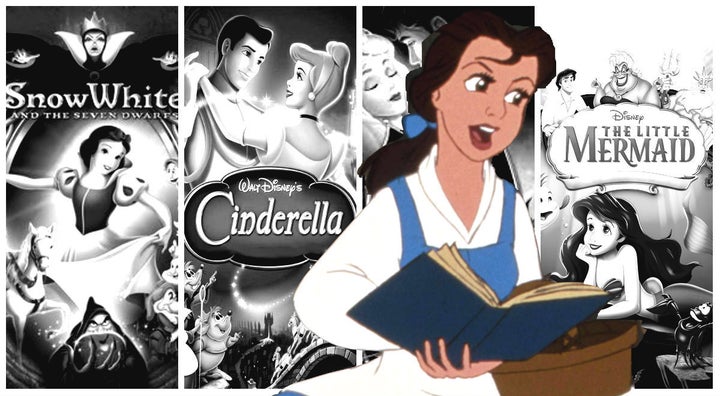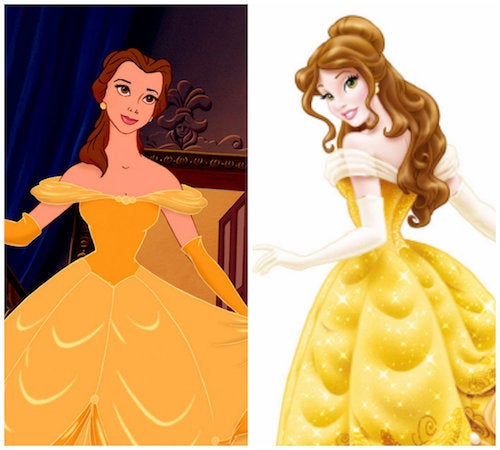

Looking back from a mountaintop of Elsa and Moana, it seems ridiculous that Ariel and Belle once struck Disney audiences as independent, tough, and feminist. But times can change quickly in children’s entertainment. Ariel and Belle were the stuff of my childhood. I was 10 by the time “Mulan” came out ― not too old to see and adore it, but old enough that it postdated my formative princess years. By the time films like “The Princess and the Frog,” “Tangled,” and “Brave” started to appear, I was long out of the target Disney demographic. When I was falling in love with “The Little Mermaid” and “Beauty and the Beast,” I wasn’t comparing them to “Mulan” and “Frozen,” obviously ― they didn’t exist yet. I was comparing them to “Sleeping Beauty” (blahsville), “Cinderella” (meh), and “Snow White” (nope).
It’s easy and, in many ways, valid to critique the feminism of films like “Beauty and the Beast” in hindsight. Twenty-five years after its debut, young people are still watching the movie, soaking up messages of mixed value, while the social context has changed and plenty of movies with independent, baggage-free heroines are now available. Is the movie a feminist manifesto? That seems like a reach. Is it a poisonous bit of anti-woman propaganda? Unclear.
Then again, I’m biased. “Beauty and the Beast” is the only movie I recall personally owning as a kid, on a VHS tape in a squeaky plastic case. I loved it. My dad touted Ariel, the heroine of “The Little Mermaid” (which actually premiered in 1989, the year after I was born), while I scoffed: Who could prefer the willingly silent, boy-obsessed mermaid princess over the bookish, brainy, self-possessed peasant girl? My favorite place was the local public library and, as my grandma will happily tell you, I was a stubborn, outspoken child; prying me away from my latest storybook and telling me to keep my opinions to myself were both losing propositions. When Belle steps into the Beast’s gleaming, palatial library, lined with stories-high bookshelves full of more novels than she could read in a lifetime, my head would spin with the romantic visions of a girl who grew up to follow Instagram accounts with names like “bookshelfporn.”
In her recent book, In Defense of the Princess: How Plastic Tiaras and Fairytale Dreams Can Inspire Strong, Smart Women, Jerramy Fine recalled similar feelings. “[T]he thing in this movie that really makes me swoon?” she wrote. “That library. When the Beast shows Belle those towering walls of floor-to-ceiling books, my heart flutters just as much as hers. And although the people in Belle’s hometown mock her constant thirst for knowledge, I love that through it all she remains an unabashed bookworm.”
Some critics counter that Belle’s reading is rarely shown in the film ― and that, unlike the practical, studious heroine of the most circulated version of the fairy tale, written by Jeanne-Marie Leprince de Beaumont in 1756, the movie Belle’s literary interests tend toward frivolous fiction, fairy tales with princes.
The Feminist Struggle To Make Belle More Than Just A Beauty
Still, even this version of Belle, who spends more time teaching the Beast to eat porridge with a spoon than lounging in his dream library with a stack of books, only appeared through determined effort. At least, that’s the contention of Linda Woolverton, who took over the script of “Beauty and the Beast” in 1988 after a number of pitches and treatments by other writers, including Jim Cox (“Oliver and Company”) and Gen LeRoy (“Walt Disney’s Wonderful World of Color”).
One treatment, crafted by British animators Richard and Jill Purdum, was scratched in 1988 after executives viewed some rough early reels and deemed it too lugubrious and dark. Once installed by Jeffrey Katzenberg, then the head of Disney’s motion picture division, to overhaul the script, Woolverton helped mold the sedate French fairy tale into a lively musical with a headstrong, yellow-clad heroine. Belle, she’s since said, was based in part on Katharine Hepburn’s character in the 1933 film “Little Women.”
“Woolverton’s fight to shape Belle into a new kind of Disney heroine was just that — a fight, every step of the way,” wrote Time’s Eliza Berman in May 2016. Her scripts took almost jaw-droppingly retrogressive rewrites:
In one scene, for example, Woolverton wrote Belle sticking pins into a map of all the places she wished to travel. By the time it got to storyboarding, Belle had been rewritten into a kitchen, decorating a cake. Woolverton protested, and the compromise that was reached had Belle with her nose in a book, a pastime at first considered too passive to be compellingly animated, which is why she always walks as she reads.
Roger Allers, the film’s story supervisor, told The Huffington Post he didn’t recall the conflict over cake decorating. “If that did happen, it must have been in the few weeks before I came on board the film,” he wrote in an email. He saw another cause behind the undermining rewrites Woolverton recalled: “The tension that existed between Linda and the story crew I think was due to her previous experience as a lone writer versus working in a collaborative group situation as was the tradition at Disney. In Story there, the script, indeed all visual ideas, are all open to review and revision in search of the best, most compelling way to tell a story. Nothing is sacred.” Not even an idealistic desire to show a princess seeking fulfillment outside of the kitchen or laundry room.
Some feminist critiques of “Beauty and the Beast” have, rightly, pointed out that the relentlessly vapid girls in the town (the Gaston fan club) serve as foils for Belle’s beauty and smarts ― implying that she is the only worthwhile woman around. “A common theme among Disney princess movies is to have the main character be isolated from other women, the rose among weeds,” noted Mari Rogers, who runs a Tumblr called Feminist Disney, in an email to HuffPost. There’s some evidence that “Beauty and the Beast” actually moved slightly away from this framing, though. A frequent tactic in earlier Disney films, right up to “The Little Mermaid,” was setting the heroine in direct opposition to a loathsome, typically older, female villain: Ursula, Cinderella’s wicked stepmother, the cruel queen of “Snow White” and the witch of “Sleeping Beauty.”
The Purdum adaptation of “Beauty and the Beast,” set in France in 1709, portrays such a character ― the sister of Maurice, who, as in the original fairy tale, is a poverty-stricken merchant. You can actually watch the choppily animated storyboards of the Purdum version’s first 20 minutes, with voiceovers, online:
In addition to a younger sister for Belle, the film featured their hateful aunt, who moves in with her brother Maurice, then a wealthy man, to help him care for his family ― and exploit him financially. When Maurice loses everything, his sister grows more and more shameless in her attempts to squeeze money out of her now-destitute brother and his family. In this write, Gaston is a wealthy and foppish suitor to whom Belle’s aunt schemes to marry her in order to open up a new pipeline of cash.
Once the Purdum script was tossed, Woolverton pushed for a version in which Belle’s interests and personal qualities come through more strongly ― and, incidentally, a version without the standard-issue bogeywoman.
A beautiful girl twirling through town with a romance novel, blissfully unencumbered with female family or friends, hardly seems the stuff of feminist revolutions ― but to see it as a positive nudge of the needle, we need only compare Belle to the previous drafts written of her by Disney creators, not to mention earlier heroines who spend most of their films asleep, voiceless, or uncomplainingly devoted to domestic drudgery. Disney’s Belle wasn’t an explosion of princess archetypes, but slight progress is still progress.
Woolverton seems well aware of the power even small changes can exert. “If you depict girls and women in these roles that we’ve never seen before,” she told Time, “then it becomes an assumption for younger generations.” Could Disney have ever moved straight from Aurora, the mostly snoozing heroine of “Sleeping Beauty,” to adventurous Merida of “Brave,” or bold Elsa of “Frozen”? Or was the normalization of Ariel, Belle, and Mulan necessary, to make a more spunky and self-possessed heroine seem not just normal, but an assumption?
The Beast Problem
Perhaps the most troubling message of “Beauty and the Beast,” for many feminist critics, lies not with Belle herself but with the Beast and his brute-force seduction. In an email to Huff Post, writer Peggy Orenstein blasted “the idea that the right woman can ‘tame’ a beastly, abusive, troubled man and turn him into a prince.” Orenstein, the author of Cinderella Ate My Daughter: Dispatches From the Front Lines of the New Girlie-Girl Culture, pointed out that both Belle’s and Ariel’s love stories contain unsettling lessons for girls about how women find partners and structure their lives. Belle’s role as the Victorian-esque angel in the house for her abusive counterpart is, she wrote, “an insidious message to girls, almost as insidious as the idea, in Disney’s version of ‘The Little Mermaid,’ that a woman would want to ― wait for it ― give up her voice to get a man. Deeply disturbing symbolism on both counts.” Rogers pointed out that Disney actually amped up this dynamic for the animated film: “In the original tale, the entire point of the story is that the beast’s scary appearance does not match his demeanor, which is consistently gentle and kind.”
That’s strike one and two for the Renaissance Disney princess films, which breathed new life into the genre after a 30-year Disney fairy tale hiatus prompted by the poor reception of “Sleeping Beauty” in 1959. Does this potentially toxic message about romance erase the gains made in crafting more ambitious, independent princesses?
Rogers doesn’t mince words about the risks of the narrative. “The love story in this one is one of the most disturbing ones in the princess lineup and rather regressive,” she wrote. “[The Beast] was undeniably verbally abusive — and used his stature to intimidate her.” What’s more, she argued, “The imprisonment adds a double layer of WTF to the situation. It perpetuates that ‘nice guy’ concept that if you can keep yourself in a woman’s company long enough/show her enough of yourself for long enough, she’ll eventually love you.”
Fine, conversely, resists the blanket condemnation of the films ― including the Belle/Beast relationship. Does the romance depict Stockholm Syndrome between a captor and his subdued victim, or an abusive relationship cycle? “I think it’s a stretch, and a tired one at that,” she told HuffPost in an email. “Because the true love story in this tale is about two marginalized people who find solace in each other.”
In the Beast, Fine sees a man who was never given a chance to love and accept himself: “Just as a child who is repeatedly told he is worthless will start believing it, the Beast has always been treated like a monster, and so after a while he started acting like one,” she wrote. “Belle is the first person in his life to see beyond this.” Meanwhile, she argues, Belle has more agency than simply a captive falling prey to distorted thinking. “Belle’s affection for him is not an irrational mental condition; rather it begins when she realises they are more alike than they are different (they’re both outsiders, they share the same values, the same love for books, etc.).” For what it’s worth, Woolverton also dismisses the argument that the relationship represents Stockholm Syndrome. “She was captured, but she transformed him,” she told IGN earlier this year. “She didn’t become, you know, an object.” Other critics, like Anna E. Altman and Gail de Vos, argue that, on the contrary, “there is nothing in the Beast for her to see until she puts it there.”


